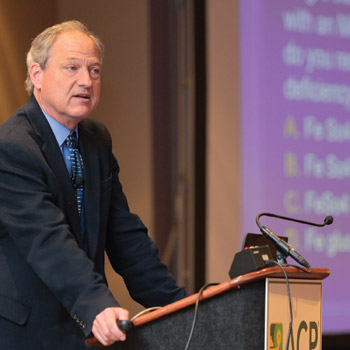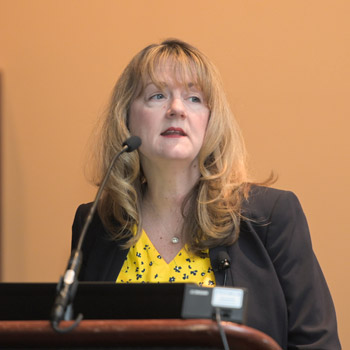The importance of ‘the caring’
The fragmented health delivery system in which physicians maneuver can interfere with patients' perception of how much a clinician cares.
As doctors, we give our patients health advice. We explain. We teach. We guide them through the journey of an illness. We help them decide what to do. We show them that we care.
This aspect of our profession, caring, is really about listening and establishing trust on a personal level. In addition to this personal level, we care on another, broader level. I have come to realize much of the College's work is caring at this larger level. We advocate for a better health care system for our patients. We design educational programs and practice support resources and try to support and improve the lives of our physicians.
Unfortunately, the fragmented health delivery system in which we maneuver can interfere with patients' perception of this caring. The complexities of hospital care lead to many unfamiliar and not-yet-trusted people wandering through as members of different teams, sometimes giving different answers to similar questions. The complexities of outpatient care lead to different clinicians using a common electronic health record but perhaps not looking far enough into the chart to find notes from colleagues and really know what is going on. When communication between physicians treating the same patient is inconsistent or absent, are we surprised patients think nobody cares?
Part of caring is the guidance that we provide. In recent years, that has received attention as “shared decision making.” This is not just some administratively mandated, patient-centered exercise. It is caring about what the patient really wants.
It is understanding what is going on in patients' lives that might help or hinder their ability to manage their own health: stresses of family, job, income, and various social determinants of health such as housing security, food and nutrition access, and neighborhood safety. These determinants have a major impact on our patients' health (see ACP's policy paper published in April 2018 in Annals of Internal Medicine) and cannot be viewed as merely more boxes to check in the electronic record at a given visit. We cannot ignore these issues if we care.
Including these social determinants in our care provides a connection, allowing us to develop strong relationships with our patients. We can really help them in ways meaningful to them, and not just meaningful to us. Only when a trusting relationship has been established can sensitive but critically important topics be broached. I know that many colleagues find these relationships to be the most gratifying aspects of our daily work. I urge us to occasionally pause and think about why.
At the end of my Introduction to Clinical Medicine course in the first year of medical school, one of my great professors and mentors distributed a copy of the famous Francis Peabody speech to Harvard medical students in 1926 (published in JAMA in 1927) in which he stated, “The secret of the care of the patient is in caring for the patient.”
So simple, yet so profound. An aphorism that keeps showing up because we understand that so much comes down to “the caring.”
Consider how we all show caring. It might be the touch on the arm, the movement away from the computer to make meaningful eye contact, the hug at the end of the visit, the tap on the knee, the simple leaning in as we listen, the reassuring pat on the shoulder. It is a palpable or visible demonstration of our humanity, our compassion, our empathy. The patient needs to feel it, or we have not fostered a therapeutic relationship. The patient needs a sense that we are listening. Many of these gestures are techniques we learn and model in medical school and residency training.
As Sir William Osler said, “The good physician treats the disease; the great physician treats the patient who has the disease.” Exactly who are the patients we face, and how do we care for them and about them?
Caring can also be viewed from a larger perspective. I have been struck by the enthusiasm patients express when learning of my involvement in health care advocacy. On many occasions I have been told, “It shows you care about fixing the crazy things that affect us every day.” And depending on the patient, that list might include access to affordable insurance, escalating drug prices, insurance company overreach, or problems with formularies and prior authorizations.
Advocacy in those areas that impact our health care delivery system is clearly where ACP belongs.
But advocacy for a physician organization must be broader and venture into areas of public policy that impact public health. So in recent years, ACP has taken bold stances on climate change as a public health issue, firearms violence as a public health issue, the health care needs of diverse populations including immigrants, and issues around substance use disorders. If you have not already read ACP's policies and statements on these topics, I urge you to do so, as I believe you will be proud.
Some may say this is not our place, or “not our lane.” We disagree. Public policy that affects health is our lane because we care. We see the medical consequences of public health problems in our individual patients. The College spoke out specifically on the firearms violence issue with an updated policy paper in November 2018.
Much publicity ensued. We physicians see the effects of firearms violence on our patients every day, both physically and emotionally. In this recent policy paper, ACP maintains that “Physicians should counsel patients on the risk of having firearms in the home, particularly when children, adolescents, people with dementia, people with mental illnesses, people with substance use disorders, or others who are at increased risk of harming themselves or others are present.” It is difficult to understand how anyone can find that inappropriate.
We will continue to advocate strongly in these areas because we care. Caring is part of our humanity. To me, it is part of what makes medicine such a rewarding profession.




